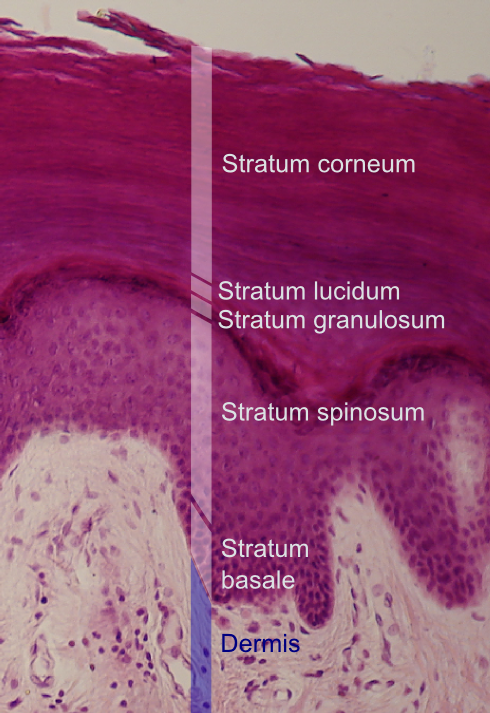Spinous Cell on:
[Wikipedia]
[Google]
[Amazon]
 Spinous cells, or prickle cells, are keratin producing epidermal cells owing their prickly appearance to their numerous intracellular connections. They make up the stratum spinosum (prickly layer) of the epidermis and provide a continuous net-like layer of protection for underlying tissue. They are susceptible to mutations caused by sunlight and can become malignant.
Spinous cells, or prickle cells, are keratin producing epidermal cells owing their prickly appearance to their numerous intracellular connections. They make up the stratum spinosum (prickly layer) of the epidermis and provide a continuous net-like layer of protection for underlying tissue. They are susceptible to mutations caused by sunlight and can become malignant.


Location
Spinous cells are found in the superficial layers of the skin. They are found in the stratum spinosum (prickly layer, spinosum layer), which lies above the stratum basale (basal layer) and below the stratum granulosum (granular layer) of the epidermis. The spinous cells are arranged several layers thick to form a net-like covering.Origin
Spinous cells originate through mitosis in the basal layer (also known as the germinative layer). They are pushed upward into the stratum spinosum by the continuous formation of new cells in the basal layer. They reach the outmost layer of the skin as flattened dead flaking skin cells we shed daily. The journey from origin to shed takes 25 to 45 days.Function
Spinous cells serve “as a physical andbiological barrier
Biology is the scientific study of life. It is a natural science with a broad scope but has several unifying themes that tie it together as a single, coherent field. For instance, all organisms are made up of cells that process hereditary in ...
to the environment, preventing penetration by irritants and allergens and loss of water while maintaining internal homeostasis. They accomplish this in two ways. First, they are keratinocytes (keratin cells) whose primary function is to produce keratin, a strong structural protein. The keratin accumulates within each spinous cell as it moves upward through the epidermis layers, until the cell is almost completely filled with hardening keratin (keratinisation). Second, the cells are bound together across their cytoplasm by keratin filaments that form cell-to-cell connections ( desmosomes).
Cancer
Squamous cell carcinoma
Squamous-cell carcinomas (SCCs), also known as epidermoid carcinomas, comprise a number of different types of cancer that begin in squamous cells. These cells form on the surface of the skin, on the lining of hollow organs in the body, and on the ...
(prickle cell carcinoma) is relatively common in people over age 60, with fair skin, and a history of longer term sun exposure. It is not as commonly known as other skin cancers because it is less likely to metastasize, but can be just as deadly if left untreated.
See also
Stratum spinosumReferences